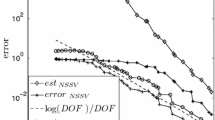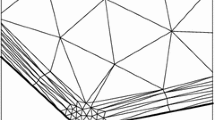Abstract
A posteriori error estimates are established for a two-step dual finite element method for singularly perturbed reaction–diffusion problems. The method can be considered as a modified least-squares finite element method. The least-squares functional is the basis for our residual-type a posteriori error estimators, which are shown to be reliable and efficient with respect to the error in an energy-type norm. Moreover, guaranteed upper bounds for the errors in the computed primary and dual variables are derived; these bounds are then used to drive an adaptive algorithm for our finite element method, yielding any desired accuracy. Our theory does not require the meshes generated to be shape-regular. Numerical experiments show the effectiveness of our a posteriori estimators.




Similar content being viewed by others
References
Ainsworth, M., Babuška, I.: Reliable and robust a posteriori error estimating for singularly perturbed reaction–diffusion problems. SIAM J. Numer. Anal. 36(2), 331–353 (1999)
Ainsworth, M., Vejchodský, T.: Fully computable robust a posteriori error bounds for singularly perturbed reaction–diffusion problems. Numer. Math. 119(2), 219–243 (2011)
Ainsworth, M., Vejchodský, T.: Robust error bounds for finite element approximation of reaction-diffusion problems with non-constant reaction coefficient in arbitrary space dimension. Comput. Methods Appl. Mech. Eng. 281, 184–199 (2014)
Brezzi, F., Fortin, M.: Mixed and Hybrid Finite Element Methods: Springer Series in Computational Mathematics, vol. 15. Springer, New York (1991)
Cai, Z., JaEun, K.: A dual finite element method for a singularly perturbed reaction-diffusion problem. SIAM J. Numer. Anal. 58(3), 1654–1673 (2020)
Cheddadi, I., Fučík, R., Prieto, M.I., Vohralík, M.: Guaranteed and robust a posteriori error estimates for singularly perturbed reaction–diffusion problems. M2AN Math. Model. Numer. Anal 43(5), 867–888 (2009)
Chen, L.: iFEM: an integrated finite element method package in MATLAB. lyc102.github.io/ifem/ (2009)
Ciarlet, P., Do, M.H., Madiot, F.: A posteriori error estimates for mixed finite element discretizations of the neutron diffusion equations. ESAIM Math. Model. Numer. Anal. 57(1), 1–27 (2023)
Creusé, E., Nicaise, S., Kunert, G.: A posteriori error estimation for the Stokes problem: anisotropic and isotropic discretizations. Math. Models Methods Appl. Sci. 14(9), 1297–1341 (2004)
Demlow, A., Kopteva, N.: Maximum-norm a posteriori error estimates for singularly perturbed elliptic reaction–diffusion problems. Numer. Math. 133(4), 707–742 (2016)
Dörfler, W.: A convergent adaptive algorithm for Poisson’s equation. SIAM J. Numer. Anal. 33(3), 1106–1124 (1996)
Durán, R.G., Lombardi, A.L.: Finite element approximation of convection diffusion problems using graded meshes. Appl. Numer. Math. 56(10–11), 1314–1325 (2006)
Ekeland, I., Témam, R.: Convex analysis and variational problems, volume 28 of Classics in Applied Mathematics. Society for Industrial and Applied Mathematics (SIAM), Philadelphia, PA, english edition, (1999). Translated from the French
Ern, A., Guermond, J.-L.: Theory and Practice of Finite Elements: Applied Mathematical Sciences, vol. 159. Springer, New York (2004)
Kopteva, N.: Maximum norm a posteriori error estimate for a 2D singularly perturbed semilinear reaction–diffusion problem. SIAM J. Numer. Anal. 46(3), 1602–1618 (2008)
Kopteva, N.: Maximum-norm a posteriori error estimates for singularly perturbed reaction–diffusion problems on anisotropic meshes. SIAM J. Numer. Anal. 53(6), 2519–2544 (2015)
Kunert, G.: A posterior \(H^1\) error estimation for a singularly perturbed reaction diffusion problem on anisotropic meshes. IMA J. Numer. Anal. 25(2), 408–428 (2005)
Prager, W., Synge, J.L.: Approximations in elasticity based on the concept of function space. Quart. Appl. Math. 5, 241–269 (1947)
Repin, S., Sauter, S., Smolianski, A.: Two-sided a posteriori error estimates for mixed formulations of elliptic problems. SIAM J. Numer. Anal. 45(3), 928–945 (2007)
Roos, H.-G., Stynes, M.: Some open questions in the numerical analysis of singularly perturbed differential equations. Comput. Methods Appl. Math. 15(4), 531–550 (2015)
Scott, L.R., Zhang, S.: Finite element interpolation of nonsmooth functions satisfying boundary conditions. Math. Comp. 54(190), 483–493 (1990)
Smears, I., Vohralík, M.: Simple and robust equilibrated flux a posteriori estimates for singularly perturbed reaction–diffusion problems. ESAIM Math. Model. Numer. Anal. 54(6), 1951–1973 (2020)
Strang, G., Fix, G.J.: An Analysis of the Finite Element Method. Prentice-Hall Series in Automatic Computation. Prentice-Hall Inc, Englewood Cliffs (1973)
Verfürth, R.: Robust a posteriori error estimators for a singularly perturbed reaction–diffusion equation. Numer. Math. 78(3), 479–493 (1998)
Vohralík, M.: Unified primal formulation-based a priori and a posteriori error analysis of mixed finite element methods. Math. Comp. 79(272), 2001–2032 (2010)
Zhang, B., Chen, S., Zhao, J.: A posteriori error estimation based on conservative flux reconstruction for nonconforming finite element approximations to a singularly perturbed reaction–diffusion problem on anisotropic meshes. Appl. Math. Comput. 232, 1062–1075 (2014)
Acknowledgements
The authors are grateful to the anonymous referee for his/her careful reading and helpful suggestions to improve the presentation of this paper.
Author information
Authors and Affiliations
Corresponding author
Ethics declarations
Conflict of interest
The authors have no competing interests to declare that are relevant to the content of this article.
Additional information
Communicated by Rolf Stenberg.
Publisher's Note
Springer Nature remains neutral with regard to jurisdictional claims in published maps and institutional affiliations.
JaEun Ku’s research is supported by NSF Grant DMS-2208289. The work of Martin Stynes is supported in part by the National Natural Science Foundation of China under Grants 12171025 and NSAF-U2230402.
Rights and permissions
Springer Nature or its licensor (e.g. a society or other partner) holds exclusive rights to this article under a publishing agreement with the author(s) or other rightsholder(s); author self-archiving of the accepted manuscript version of this article is solely governed by the terms of such publishing agreement and applicable law.
About this article
Cite this article
Ku, J., Stynes, M. A posteriori error estimates for a dual finite element method for singularly perturbed reaction–diffusion problems. Bit Numer Math 64, 7 (2024). https://doi.org/10.1007/s10543-024-01008-x
Received:
Accepted:
Published:
DOI: https://doi.org/10.1007/s10543-024-01008-x




